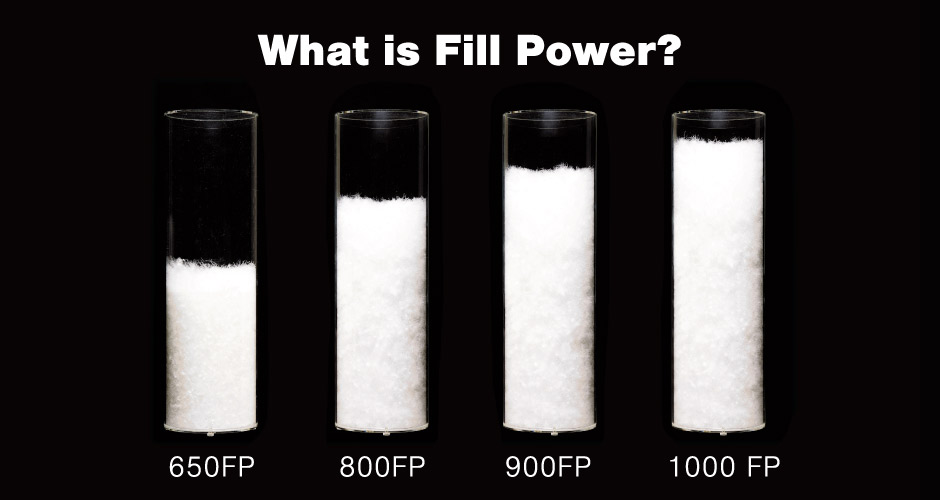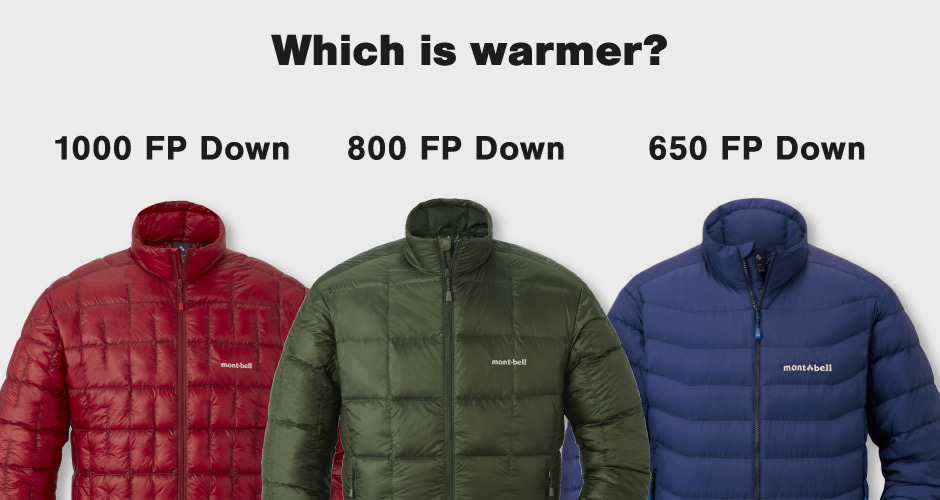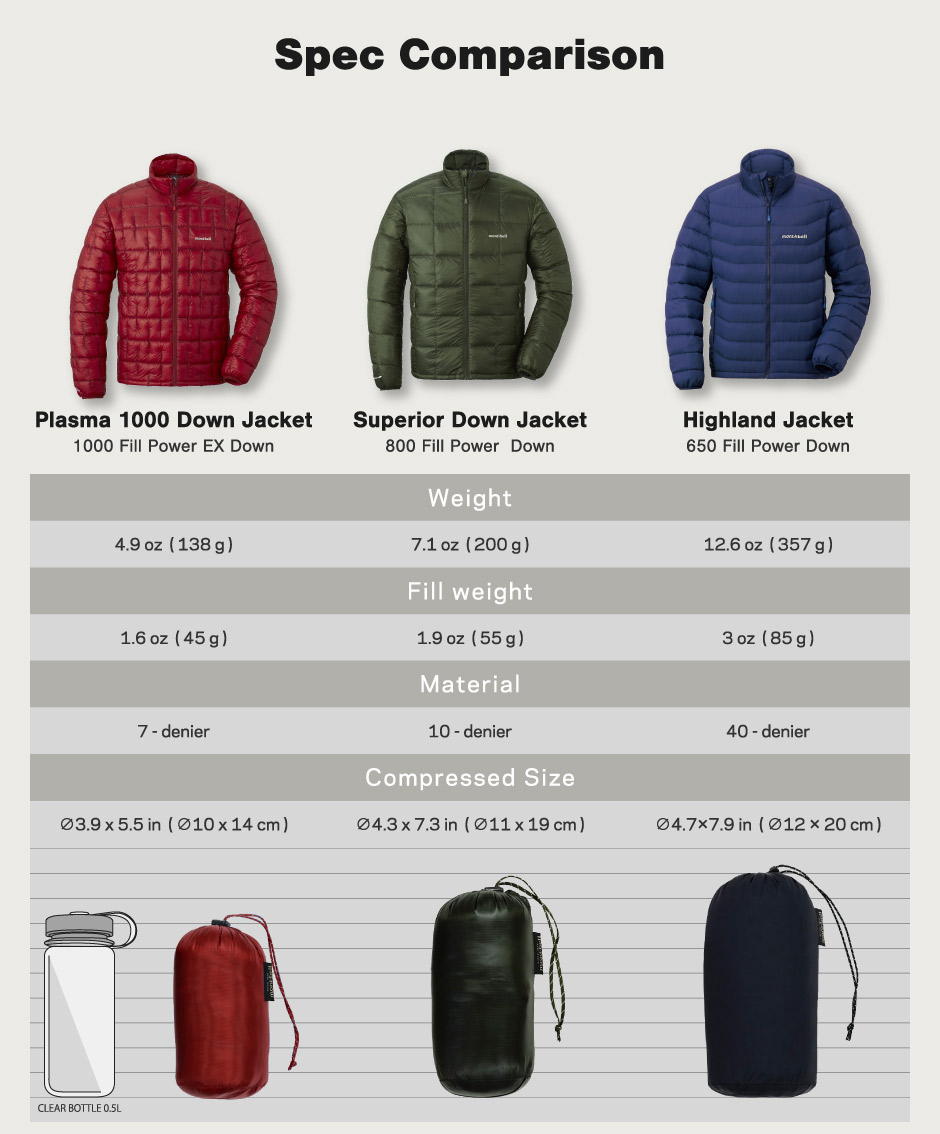Down Fill Power: Explained

Fill power is a commonly used term related to down products that can be easily misunderstood. We’ve put together this brief guide to help clarify this confusion and make choosing down jackets and sleeping bags a smoother and more enjoyable process.
Let's start with a quiz. Look at the down cylinders in the image below and try to guess which amount of down weighs more.

Would it surprise you to learn that each cylinder of down weighs the same? Each of the cylinders above only holds 1.1 oz (30 g) of down. The technical definition of fill power is the measure of volume 1.1 oz (30 g) of down displaces in a cylinder. The above is a great visual for what that means. In plain English, higher fill power down will be fluffier, thus holding more air and taking up more space. Generally, 600-700 fill power down is considered good quality, with 700+ in the realm of high quality. Montbell uses 650 to 1000 fill power down, giving our down products amazing loft, which in turn traps a high volume of air to keep you warm and insulated.
The most common misunderstanding is that fill power is the sole indicator of how warm a down product is going to be.
Despite what you may think at first glance, higher fill power numbers don’t relate directly to how warm the finished product is going to be. A product made with 650 fill power down could be designed to be warmer than a product made using 1000 fill power down.
A practical way of thinking about fill power: Using higher fill power down allows us to create lighter, more compact products.
When designing our down products, we start the process with a specific thermal profile in mind. In order to achieve that thermal profile, we know we need to fill a certain amount of space inside the product with down. While the space inside the product is constant, the materials we choose to use are not. We could use good quality down, or super high quality down. We already know that super high quality down will take up more space. So by using this material, we are able to fill the product while using less down. The result is a product that achieves that specific thermal profile, but at a lighter weight and more compact size.
A better understanding of warmth requires knowing the amount of down and the quality of the down used in a product.
Let’s use a real world example, comparing three products in our sweater-weight warmth category.

When comparing the Plasma 1000 Down Jacket (left), the Superior Down Jacket (center) and the Highland Jacket (right), customers often focus in on the impressive 1000 fill power of the Plasma and assume it is the warmest option. Technically, the Highland is a little bit warmer than the Plasma and the Superior, but roughly they provide about the same level of warmth. We categorize these three jackets in our sweater weight warmth category because they provide the equivalent warmth of a sweater. What we need to think about is how much down is inside each jacket. Although the Plasma is filled with 1000 fill power down, it only needs 1.6 oz (45 g) of down to fill up the volume inside the jacket. On the other hand, in order to fill the volume inside the Superior, we need 1.9 oz (55 g) of 800 fill power down. For the Highland, we need to use 3 oz (85 g) of 650 fill power down.
So if these three jackets provide roughly the same amount of warmth, which do I choose?
In the example above, let’s take a look at the specs of each product. The Plasma 1000 Down Jacket has an overall weight of 4.9 oz (138 g). Compare that to the Superior's 7.1 oz (200 g) and the Highland’s 12.6 oz (357 g).

See the difference? By using a super high quality fill power, it allows us to design products that are lighter and more compact, yet keeping the same level of warmth.
The choice is really more about your needs. Do you need the absolute lightest and most compact option? The Plasma ticks off both those boxes and because it uses extremely high quality, technical materials, it has a price tag to match those materials. Perhaps you don't need your down jacket to be as light and compact as possible or want a less expensive option, the Superior has an excellent balance of lightweight and compactness that make it a fan favorite. Concerned with the delicate nature of ultralight materials and not really worried about weight? The Highland offers a great value, has a higher denier fabric which is a little more durable compared to lower denier fabric and it is still plenty lightweight.
Instead of focusing in on fill power, we recommend taking a look at the Down Comparison Chart below. The jackets are aligned by their overall weight and relative warmth. Jackets closer to the left side of the chart are light and jackets closer to the right are heavier. Jackets higher in position are warmer than those below. We’ve also divided them up by weight class; sweater weight, mid weight and heavy weight. Ask yourself what your needs are and then use the chart to help hone in on the right option for you.

